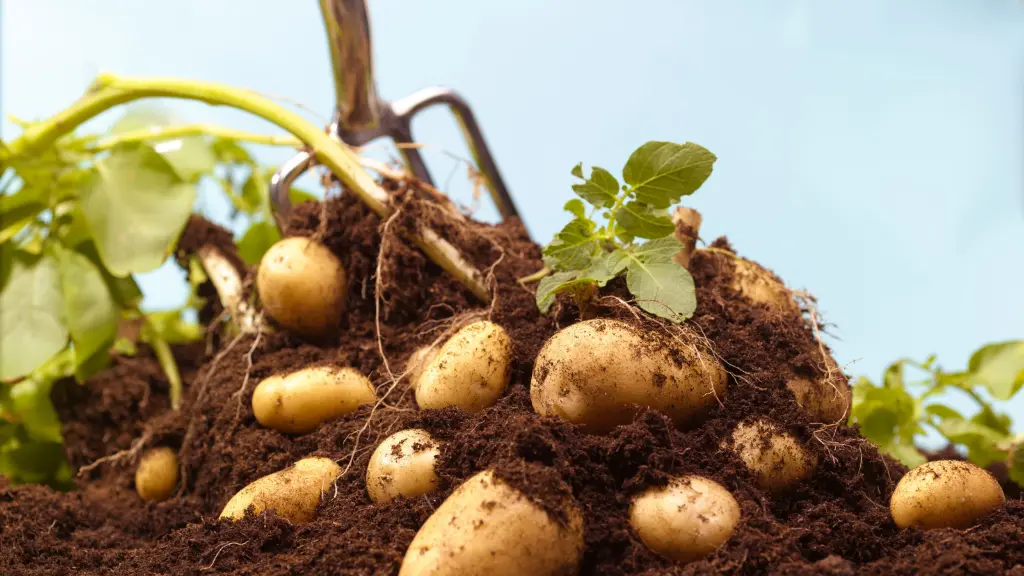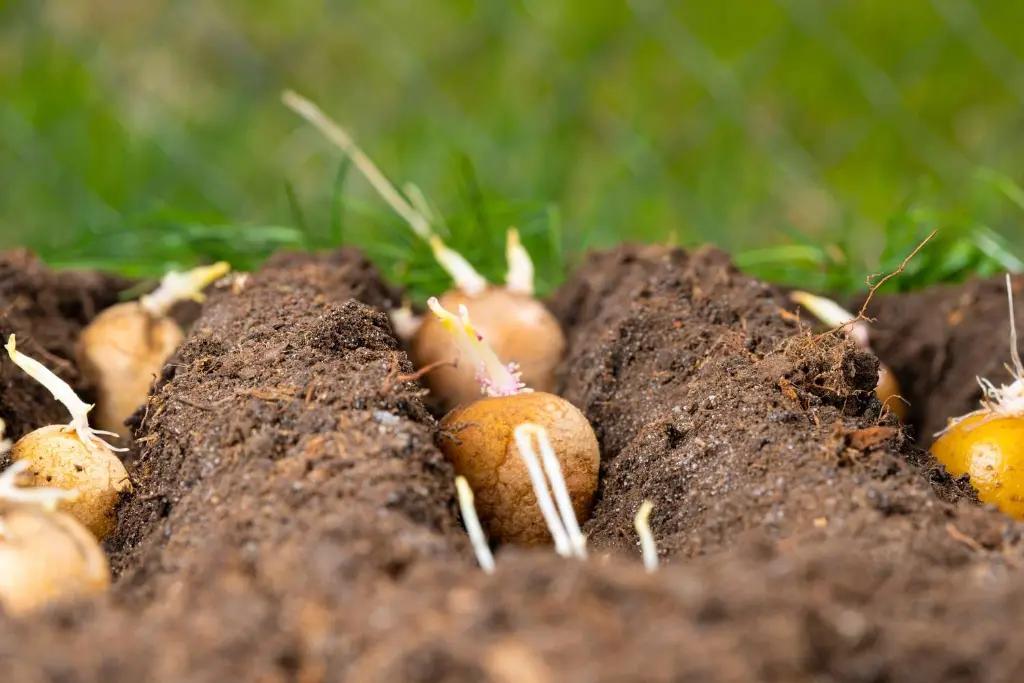
Potatoes are a versatile and nutritious staple crop that can be grown in a variety of climates and soil types. Whether you’re a seasoned gardener or a novice, planting potatoes can be a rewarding experience. This comprehensive guide will walk you through the entire process, from selecting the right potato varieties to harvesting your crop. By following these expert tips, you’ll be well on your way to growing a bountiful potato harvest.
Introduction to Potato Planting

Potatoes (Solanum tuberosum) are one of the most widely grown root vegetables in the world. They are relatively easy to grow and can be cultivated in various conditions, making them an excellent choice for home gardeners. Potatoes are grown from «seed potatoes,» which are small tubers or pieces of tubers specifically intended for planting.
Benefits of Growing Potatoes
- Nutritional Value: Potatoes are rich in vitamins, minerals, and fiber.
- Versatility: They can be used in numerous recipes, from mashed potatoes to French fries.
- Storage: Potatoes store well and can provide food throughout the year.
- Yield: A small plot can yield a substantial harvest.
Selecting Potato Varieties
Choosing the right potato variety is crucial for a successful harvest. Potatoes come in various types, each with its own unique characteristics and uses. Here are some popular varieties:
Early Potatoes
- First Early: Harvested in about 10-12 weeks. Examples include ‘Red Duke of York’ and ‘Rocket’.
- Second Early: Harvested in about 14-16 weeks. Examples include ‘Kestrel’ and ‘Charlotte’.
Maincrop Potatoes
- Maincrop: Harvested in about 20 weeks. Examples include ‘King Edward’ and ‘Maris Piper’.
Specialty Potatoes
- Fingerling: Small, elongated tubers with a unique flavor. Examples include ‘Russian Banana’ and ‘French Fingerling’.
- Blue/Purple: Potatoes with blue or purple flesh and skin. Examples include ‘Purple Majesty’ and ‘All Blue’.
Factors to Consider
- Climate: Choose varieties suited to your local climate.
- Disease Resistance: Opt for varieties resistant to common potato diseases.
- Cooking Preferences: Select varieties that match your preferred cooking methods (e.g., baking, boiling, frying).
Preparing the Soil
Potatoes thrive in well-drained, fertile soil with a slightly acidic pH (5.0-6.5). Proper soil preparation is essential for healthy plants and a good yield.
Soil Preparation Steps
- Test the Soil: Check the pH and nutrient levels.
- Amend the Soil: Add organic matter, such as compost or well-rotted manure, to improve fertility and drainage.
- Till the Soil: Loosen the soil to a depth of about 12 inches to ensure good root development.
- Remove Weeds: Clear the area of weeds and debris.
Planting Potatoes
Planting potatoes at the right time and in the right way is crucial for a successful harvest.
When to Plant
- Early Varieties: Plant in early spring, 2-4 weeks before the last frost date.
- Maincrop Varieties: Plant in mid to late spring, after the soil has warmed up.
How to Plant
- Chit the Seed Potatoes: Place seed potatoes in a cool, light place to encourage sprouting. This process, known as «chitting,» typically takes 4-6 weeks.
- Cut the Seed Potatoes: If the seed potatoes are large, cut them into pieces with at least one «eye» (sprout) each. Allow the cut pieces to dry for a few days before planting to reduce the risk of rotting.
- Planting Depth and Spacing:
- Dig trenches 6-8 inches deep.
- Space seed potatoes 12 inches apart in the trench.
- Space rows 24-36 inches apart.
- Cover with 4 inches of soil, leaving the rest to fill in as the plants grow.
Seasonal Care Guide
Proper care throughout the growing season is essential for a healthy potato crop. Here’s a handy seasonal guide to help you manage your potato care throughout the year:
| Month | Task |
|---|---|
| January | Planning and ordering seed potatoes |
| February | Chitting seed potatoes |
| March | Soil preparation |
| April | Planting early varieties |
| May | Planting maincrop varieties |
| June | Hilling up soil around plants, watering, weeding |
| July | Monitoring for pests and diseases, continued hilling and watering |
| August | Harvesting early varieties, continued care for maincrop |
| September | Harvesting maincrop varieties |
| October | Final harvesting, soil preparation for next season |
| November | Storing harvested potatoes |
| December | Reviewing the season, planning for next year |
Watering
- Consistency: Keep the soil consistently moist but not waterlogged.
- Avoid Overhead Watering: Use a soaker hose or drip irrigation to prevent disease.
Fertilizing
- Early Growth: Use a balanced fertilizer (10-10-10) when planting.
- Mid-Growth: Apply a side dressing of fertilizer once the plants are about 6 inches tall.
Hilling
- Purpose: Hilling helps protect tubers from sunlight (which can turn them green and toxic) and supports the plant.
- How to Hill: As the plants grow, mound soil around the stems, covering the lower leaves. Repeat every few weeks.
Pest and Disease Management
- Common Pests: Colorado potato beetles, aphids, and slugs.
- Common Diseases: Late blight, early blight, and scab.
- Control Methods: Regularly inspect plants, use organic or chemical treatments as needed, and practice crop rotation.
Managing Pests and Diseases
Effective pest and disease management is crucial for a successful potato harvest. Here are some common issues and how to manage them:
Pests
Colorado Potato Beetle
- Identification: Yellow and black striped beetles.
- Damage: Chew on leaves, reducing plant vigor.
- Control: Handpick beetles, use neem oil, or apply insecticides.
Aphids
- Identification: Small, green or black insects.
- Damage: Suck sap from plants, causing stunted growth.
- Control: Use insecticidal soap or introduce beneficial insects like ladybugs.
Slugs
- Identification: Soft-bodied, slimy pests.
- Damage: Eat holes in leaves and tubers.
- Control: Use slug traps, diatomaceous earth, or slug pellets.
Diseases
Late Blight
- Identification: Dark, water-soaked spots on leaves and stems.
- Damage: Can cause complete crop loss.
- Control: Use disease-resistant varieties, practice crop rotation, and apply fungicides.
Early Blight
- Identification: Small, dark spots on leaves, often with a yellow halo.
- Damage: Reduces photosynthesis, leading to smaller tubers.
- Control: Remove infected leaves, practice crop rotation, and apply fungicides.
Scab
- Identification: Rough, corky patches on tubers.
- Damage: Affects tuber appearance and storage quality.
- Control: Maintain slightly acidic soil, use disease-free seed potatoes, and rotate crops.
Harvesting and Storing Potatoes
Knowing when and how to harvest your potatoes is crucial for maximizing yield and storage quality.
When to Harvest
- Early Varieties: Harvest when plants begin to flower.
- Maincrop Varieties: Harvest when the foliage turns yellow and dies back.
How to Harvest
- Loosen the Soil: Use a garden fork to gently loosen the soil around the plants.
- Lift the Tubers: Carefully lift the plants, shaking off excess soil.
- Cure the Potatoes: Allow freshly harvested potatoes to dry in a cool, dark place for about 1-2 weeks. This helps toughen the skin for better storage.
Storing Potatoes
- Conditions: Store in a cool, dark, and well-ventilated area (45-50°F) with high humidity.
- Storage Duration: Early varieties last a few months, while maincrop varieties can last up to six months.
- Avoid Light: Exposure to light can cause greening and solanine production, making the potatoes toxic.
Common Problems and Solutions
Even with careful planning and management, you may encounter some problems when growing potatoes. Here are some common issues and how to address them:
Small or Misshapen Tubers
- Cause: Inconsistent watering, poor soil fertility, or overcrowding.
- Solution: Ensure consistent moisture, fertilize appropriately, and provide adequate spacing.
Green Potatoes
- Cause: Exposure to sunlight.
- Solution: Hill soil around plants to cover tubers
, and store harvested potatoes in the dark.
Cracked Tubers
- Cause: Irregular watering, causing rapid growth spurts.
- Solution: Maintain consistent soil moisture.
Rotting Tubers
- Cause: Overwatering or poor drainage.
- Solution: Improve soil drainage and avoid overwatering.
Conclusion
Growing potatoes can be a fulfilling and productive gardening endeavor. By selecting the right varieties, preparing the soil, planting correctly, and providing proper care throughout the growing season, you can enjoy a bountiful harvest of delicious and nutritious potatoes. Remember to manage pests and diseases proactively, and harvest and store your potatoes properly to ensure they last through the year. Happy gardening!
Seasonal Care Guide
Here’s a handy seasonal guide to help you manage your potato care throughout the year:
| Month | Task |
|---|---|
| January | Planning and ordering seed potatoes |
| February | Chitting seed potatoes |
| March | Soil preparation |
| April | Planting early varieties |
| May | Planting maincrop varieties |
| June | Hilling up soil around plants, watering, weeding |
| July | Monitoring for pests and diseases, continued hilling and watering |
| August | Harvesting early varieties, continued care for maincrop |
| September | Harvesting maincrop varieties |
| October | Final harvesting, soil preparation for next season |
| November | Storing harvested potatoes |
| December | Reviewing the season, planning for next year |
By following this guide and investing a little time and effort, you can grow your own delicious and nutritious potatoes at home. Enjoy the process and the rewards that come with a successful potato harvest!




